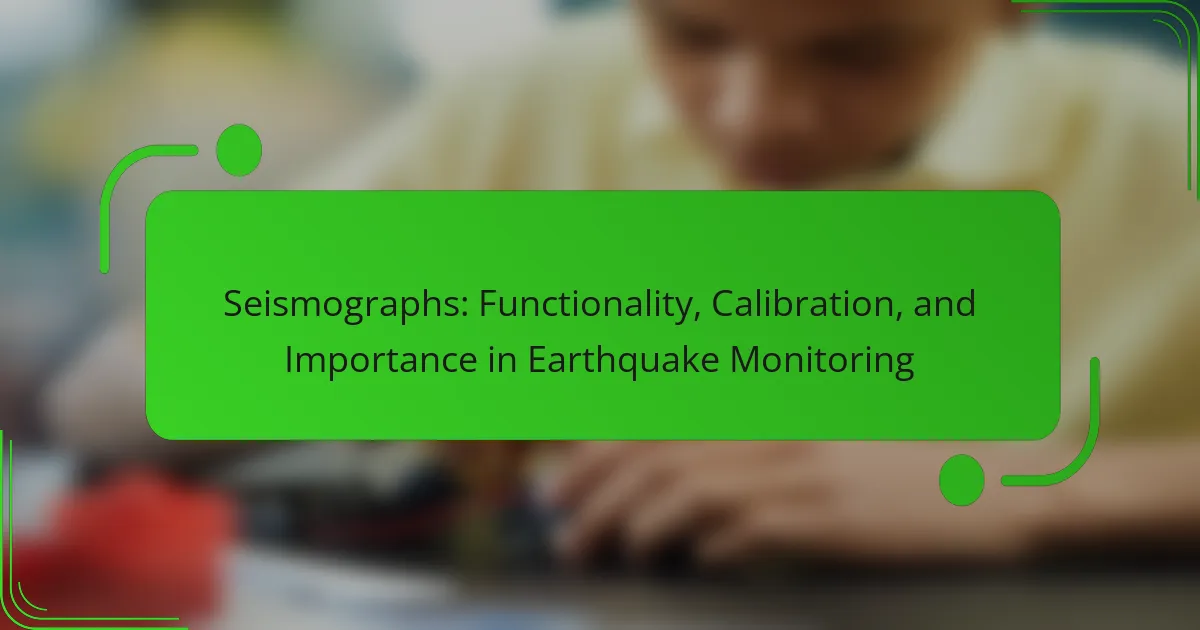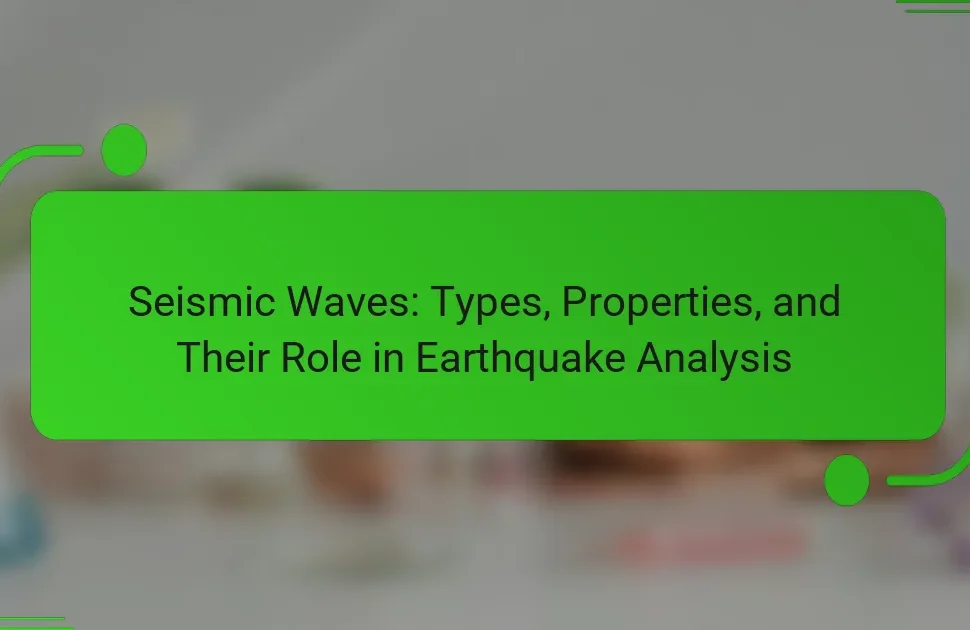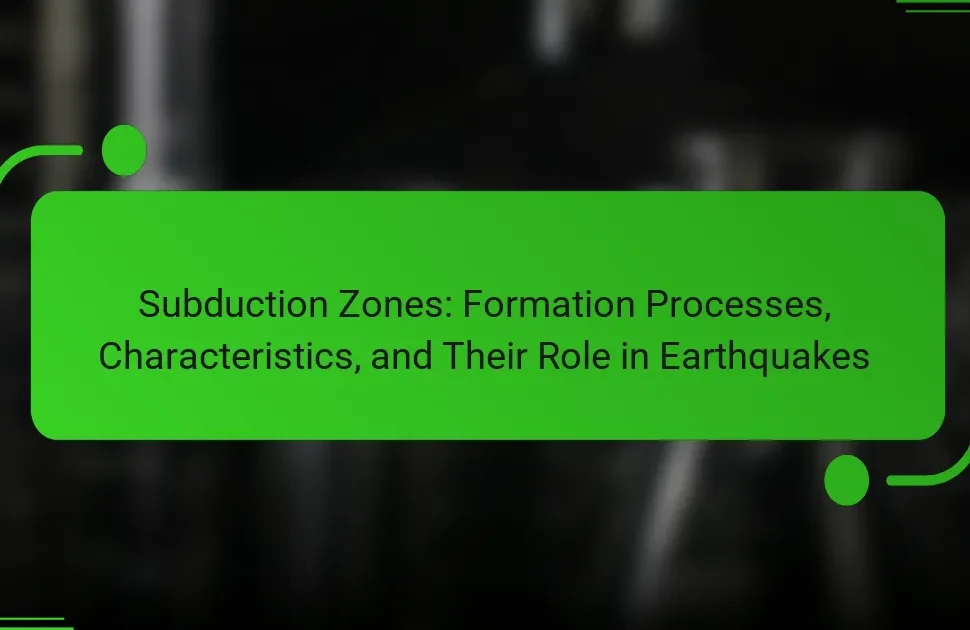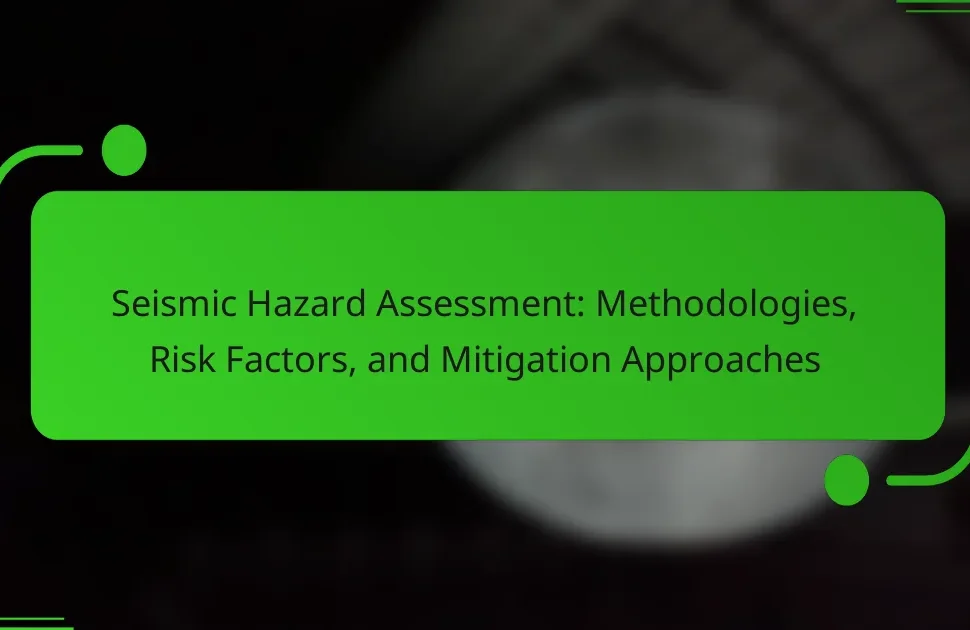Seismographs are specialized instruments designed to measure and record ground motion during earthquakes by detecting vibrations from seismic waves. These devices consist of a mass, a spring, and a recording mechanism, which together produce a seismogram capturing the relative motion between the stationary mass and the moving ground. Calibration of seismographs is essential for ensuring accurate measurements, involving the adjustment of sensitivity and response characteristics through controlled seismic signals. The data generated by seismographs is vital for analyzing seismic activity, issuing timely warnings, and enhancing earthquake research, ultimately contributing to improved safety measures and building codes.

What are Seismographs?
Seismographs are instruments that measure and record the motion of the ground during an earthquake. They detect vibrations caused by seismic waves. Seismographs consist of a mass, a spring, and a recording device. When the ground shakes, the mass remains stationary while the base moves. This relative motion is recorded as a seismogram. Seismographs can detect both small and large earthquakes. They provide valuable data for understanding seismic activity. This data helps in earthquake research and hazard assessment.
How do Seismographs function in monitoring earthquakes?
Seismographs function by detecting and recording ground motion caused by seismic waves during an earthquake. These instruments consist of a mass suspended on a spring, which remains stationary while the ground moves. When seismic waves reach the seismograph, the ground’s motion causes the mass to shift. This movement is converted into an electrical signal. The signal is then recorded on a rotating drum or digital storage, creating a seismogram. Seismograms display the amplitude and frequency of the seismic waves, allowing scientists to analyze the earthquake’s characteristics. Seismographs are essential for determining the earthquake’s location, depth, and magnitude, providing crucial data for understanding seismic activity.
What are the key components of a Seismograph?
A seismograph consists of several key components. These components include a mass, a spring, a recording device, and a base. The mass is suspended and remains stationary during ground motion. The spring connects the mass to the base, allowing it to move in response to seismic waves. The recording device captures the relative motion between the mass and the base. This setup enables the seismograph to convert ground motion into a visual record. The accuracy of the seismograph is crucial for monitoring earthquakes effectively.
How do these components interact to detect seismic activity?
Seismographs detect seismic activity through a combination of sensors and recording systems. The primary components include a mass, a spring, and a recording device. When seismic waves reach the seismograph, they cause the ground to move. This movement leads to the mass remaining stationary due to inertia. As the ground shakes, the spring compresses or stretches, which allows the mass to move relative to the ground. The displacement of the mass is recorded by the device, typically in the form of a trace on a rotating drum or digital display. This trace represents the amplitude and frequency of the seismic waves. The interaction of these components enables the seismograph to accurately capture and record seismic events.
What types of Seismographs are there?
There are several types of seismographs. The main types include analog seismographs, digital seismographs, and strong-motion seismographs. Analog seismographs use mechanical components to record seismic waves on paper. Digital seismographs convert seismic signals into digital data for analysis. Strong-motion seismographs measure ground acceleration during significant seismic events. Each type serves specific purposes in monitoring and analyzing earthquakes. These distinctions are crucial for understanding seismic activity and improving safety measures.
How do analog Seismographs differ from digital Seismographs?
Analog seismographs record seismic waves using a physical medium, while digital seismographs use electronic sensors and digital data processing. Analog devices rely on a pen that traces movements on a rotating drum, creating a continuous line graph. Digital devices convert seismic signals into numerical data for analysis.
Analog seismographs provide a visual representation of seismic activity in real-time. They are often more sensitive to low-frequency waves. Digital seismographs can store large amounts of data and facilitate advanced processing techniques.
The transition from analog to digital technology began in the late 20th century. Digital seismographs have become standard due to their accuracy and ease of data sharing.
What are the advantages of each type?
Seismographs can be categorized into different types, each with distinct advantages. Analog seismographs offer simplicity and reliability. They provide continuous records of seismic waves without the need for complex electronics. Digital seismographs allow for high-resolution data collection. They can easily store and transmit data for further analysis. Strong-motion seismographs are designed to capture intense ground shaking. They provide critical information for understanding earthquake impacts. Broadband seismographs can detect a wide range of seismic frequencies. This versatility aids in comprehensive seismic analysis. Each type of seismograph is tailored to specific monitoring needs, enhancing earthquake preparedness and research.
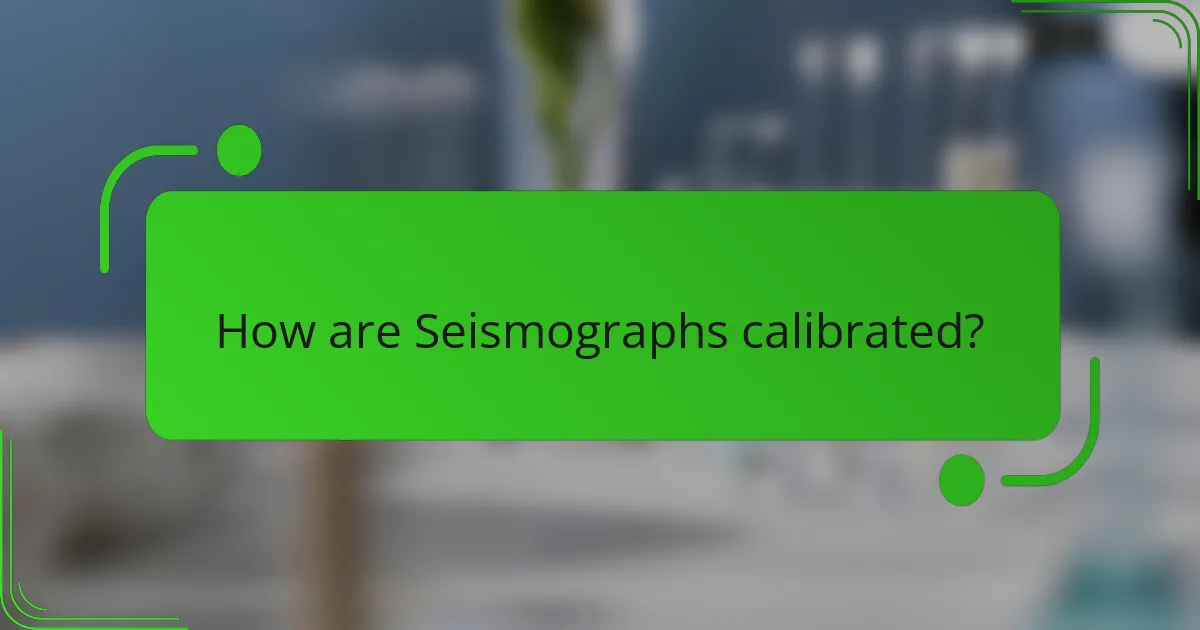
How are Seismographs calibrated?
Seismographs are calibrated by adjusting their sensitivity and response characteristics. Calibration involves using known seismic signals to ensure accurate measurements. Technicians generate controlled vibrations to test the seismograph’s response. They compare the recorded data to the expected output. Adjustments are made to the instrument settings based on this comparison. Regular calibration is necessary to maintain accuracy over time. This process helps in accurately detecting and measuring seismic events. Proper calibration ensures reliable data for earthquake monitoring and research.
Why is calibration important for Seismographs?
Calibration is important for seismographs because it ensures accurate measurement of seismic activity. Seismographs detect ground motion caused by earthquakes. Calibration aligns the instrument’s readings with known standards. This process minimizes errors in data interpretation. Accurate data is crucial for understanding earthquake magnitudes. It also aids in assessing potential risks to infrastructure. Regular calibration maintains the reliability of seismographic data over time. Studies show that uncalibrated instruments can produce misleading results, affecting safety measures.
What are the standard calibration procedures for Seismographs?
Standard calibration procedures for seismographs include several key steps. First, the instrument is leveled to ensure accurate measurements. Next, a known seismic signal is generated, often using a calibration shaker. The seismograph records this signal, allowing for comparison with the expected output. The recorded data is analyzed to determine the instrument’s response characteristics. Adjustments are made to the instrument settings as needed. This process ensures that the seismograph accurately measures ground motion. Regular calibration is essential for maintaining data integrity in earthquake monitoring. Calibration usually occurs annually or after significant events.
How often should Seismographs be calibrated?
Seismographs should be calibrated at least once a year. Regular calibration ensures accurate measurements of seismic activity. The calibration frequency may increase in regions with high seismicity or after significant seismic events. Proper calibration maintains the instrument’s precision and reliability. Studies indicate that annual calibration improves data quality significantly. Calibration checks also help identify any potential issues with the equipment. Following these guidelines enhances the effectiveness of earthquake monitoring systems.
What challenges are faced during the calibration process?
Calibration of seismographs faces several challenges. One challenge is achieving accurate alignment of sensors. Misalignment can lead to erroneous readings. Environmental factors also complicate calibration. Temperature fluctuations can affect sensor performance. Additionally, background noise interferes with signal clarity. This noise can originate from nearby machinery or natural sources. Another challenge is maintaining consistency over time. Calibration may drift due to equipment wear or changes in the environment. Regular recalibration is essential to ensure data reliability. These challenges highlight the complexity of precise earthquake monitoring.
How can environmental factors affect Seismograph calibration?
Environmental factors can significantly affect seismograph calibration. Temperature fluctuations can cause changes in the materials of the seismograph. These changes may lead to shifts in sensitivity and accuracy. Humidity levels can also impact the electronic components of the device. High humidity can cause corrosion, while low humidity may lead to static electricity build-up. Additionally, vibrations from nearby activities can interfere with readings. This interference can result in inaccurate data and misinterpretation of seismic events. Proper calibration must account for these environmental variables to ensure reliable measurements.
What techniques can be used to overcome calibration challenges?
Techniques to overcome calibration challenges in seismographs include regular maintenance, using reference standards, and implementing automated calibration systems. Regular maintenance ensures that the equipment functions optimally and reduces errors. Using reference standards provides a baseline for accurate measurements. Automated calibration systems can adjust settings in real-time, enhancing precision. Research by the US Geological Survey emphasizes the importance of these methods in maintaining the reliability of seismic data.
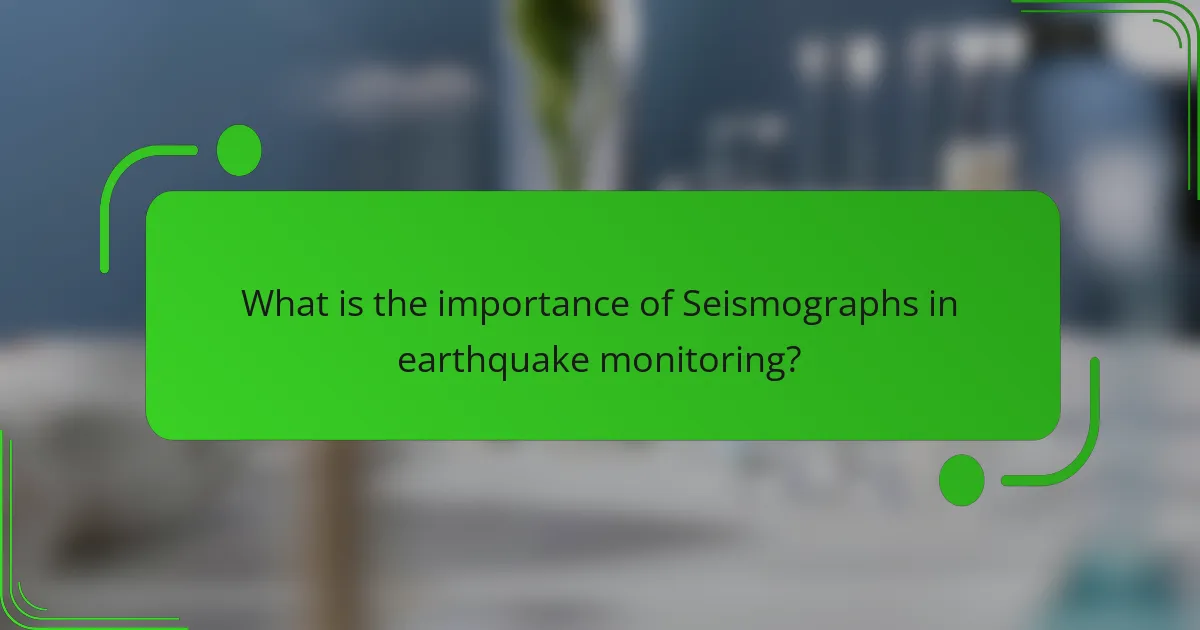
What is the importance of Seismographs in earthquake monitoring?
Seismographs are crucial instruments in earthquake monitoring. They detect and record seismic waves generated by earthquakes. This data helps scientists analyze the magnitude and location of seismic events. Accurate readings from seismographs enable timely warnings to be issued. They also assist in understanding earthquake patterns and behaviors. Historical seismograph data contributes to improved building codes and safety measures. The use of seismographs has been fundamental in reducing earthquake-related risks. Their role in research aids in advancing seismology as a science.
How do Seismographs contribute to earthquake preparedness?
Seismographs contribute to earthquake preparedness by detecting and recording seismic waves from earthquakes. They provide real-time data on the location, depth, and magnitude of seismic events. This information helps emergency services assess potential impacts and respond effectively. For example, the United States Geological Survey (USGS) uses seismographs to monitor seismic activity and issue alerts. These alerts can give people crucial seconds to take cover before shaking begins. Additionally, the data collected aids in understanding earthquake patterns and risks in specific regions. This knowledge is essential for developing building codes and safety regulations. Overall, seismographs are vital tools for enhancing community readiness for earthquakes.
What data do Seismographs provide to emergency services?
Seismographs provide critical data to emergency services during seismic events. They measure ground motion and vibrations caused by earthquakes. This data includes the magnitude of the quake, which indicates its strength. Seismographs also record the location of the earthquake’s epicenter. They provide information on the depth of the seismic activity. Additionally, the timing of the seismic waves is captured, which helps in assessing the event’s impact. This data is essential for emergency response planning and public safety measures. Accurate seismographic data can help predict aftershocks, allowing for timely evacuations and resource allocation.
How does Seismograph data influence building codes and regulations?
Seismograph data directly influences building codes and regulations by providing critical information on seismic activity. This data helps engineers assess the potential risks of earthquakes in specific regions. Building codes are often updated to reflect the latest findings from seismographic studies. For instance, areas with higher seismic risk may require stricter design standards. These standards ensure that structures can withstand seismic forces. The International Building Code incorporates seismograph data to enhance safety measures. Historical earthquake data informs the development of these regulations. As a result, building codes evolve to minimize damage and protect lives during seismic events.
What role do Seismographs play in scientific research?
Seismographs play a crucial role in scientific research by detecting and recording seismic waves generated by earthquakes. They provide valuable data on the location, depth, and magnitude of seismic events. This information helps scientists understand the Earth’s internal structure and tectonic processes. Seismographs also aid in assessing earthquake risks and improving safety measures. Furthermore, they contribute to the study of other geological phenomena, such as volcanic activity and landslides. The data collected from seismographs is essential for developing early warning systems and enhancing preparedness for natural disasters.
How do researchers use Seismograph data to understand tectonic activity?
Researchers use seismograph data to analyze tectonic activity by measuring ground motion. Seismographs capture vibrations caused by earthquakes and tectonic shifts. The data reveals the intensity, duration, and frequency of seismic waves. Researchers can identify the location and depth of tectonic events through this information. By studying patterns in the data, they can infer fault lines and plate boundaries. Historical seismograph records help in understanding past tectonic activity. This analysis aids in predicting future seismic events. Accurate interpretations contribute to earthquake preparedness and risk assessment.
What advancements in technology have improved Seismograph data analysis?
Advancements in technology have significantly improved seismograph data analysis through enhanced sensors and real-time data processing. Modern seismographs utilize high-sensitivity sensors that detect minute ground movements. These sensors provide more accurate readings compared to older models. Additionally, advancements in digital signal processing algorithms allow for better noise reduction in seismic data. This results in clearer signals for analysis. Cloud computing facilitates the storage and sharing of large datasets, enabling collaborative research. Machine learning techniques are now applied to identify patterns in seismic activity. These technologies have led to faster and more precise earthquake detection and analysis.
What best practices should be followed for using Seismographs effectively?
To use seismographs effectively, ensure proper calibration and maintenance. Regular calibration enhances accuracy in measuring seismic waves. Position seismographs in stable locations away from vibrations. This minimizes noise interference in data collection. Utilize appropriate software for data analysis and interpretation. This aids in understanding seismic activity trends. Train personnel in operating seismographs and interpreting data. Knowledgeable users can make informed decisions during seismic events. Finally, regularly review and update protocols based on advancements in technology. This ensures optimal performance and reliability in monitoring earthquakes.
Seismographs are essential instruments that measure and record ground motion during earthquakes, providing critical data for understanding seismic activity. This article explores the functionality of seismographs, detailing their key components, types, and the calibration processes necessary for accurate measurements. It also discusses the importance of seismographs in earthquake monitoring, including their role in enhancing preparedness, informing building codes, and contributing to scientific research. Additionally, advancements in technology and best practices for effective use are highlighted, emphasizing the significance of reliable seismographic data in assessing earthquake risks and improving safety measures.
